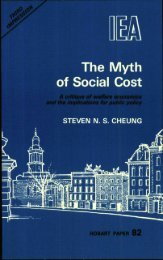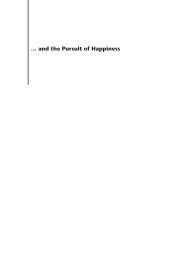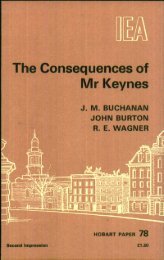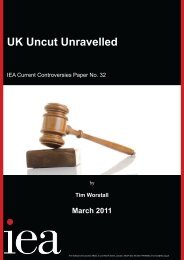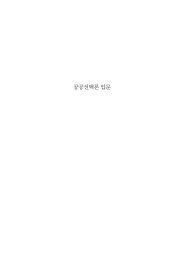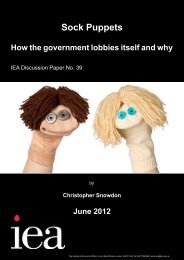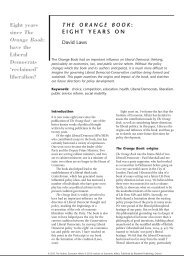Hayek's The Constitution of Liberty - Institute of Economic Affairs
Hayek's The Constitution of Liberty - Institute of Economic Affairs
Hayek's The Constitution of Liberty - Institute of Economic Affairs
You also want an ePaper? Increase the reach of your titles
YUMPU automatically turns print PDFs into web optimized ePapers that Google loves.
h ay e k ’ s t h e c o n s t i t u t i o n o f l i b e r t y<br />
s t o p p i n g c o e r c i o n i n e m p l o y m e n t<br />
coercion is today the main aim <strong>of</strong> unions’ (275). Having a<br />
monopoly <strong>of</strong> labour is crucial to this aim, for if unions effectively<br />
control all the potential workers, employers must bargain with<br />
them. Unions thus use coercive means ‘to force unwilling workers<br />
into membership and to keep non-members out <strong>of</strong> employment’<br />
(268). If governments followed the Rule <strong>of</strong> Law, they would prevent<br />
coercive labour monopolies; but instead they have sanctioned or<br />
tolerated hostile picketing in large numbers, closed or union shop<br />
contracts, and secondary strikes and boycotts – all techniques<br />
that Hayek would prohibit (274–5, 278–9). Unions get away with<br />
coercive techniques partly because they wield great political influence<br />
and partly because the public mistakenly thinks that union<br />
activities benefit the entire working class. Economists can render a<br />
public service by correcting this misconception (273–4).<br />
Unions claim to benefit all workers by raising the general<br />
level <strong>of</strong> wages. To refute this claim, Hayek builds on a distinction<br />
between real wages and money wages – a distinction that<br />
had been important to his business cycle theory and his critique<br />
<strong>of</strong> Keynesian economics. In a 1942 essay he notes that ‘real wages’<br />
commonly refers to ‘the relation between wages as received by<br />
the worker and the prices <strong>of</strong> the commodities on which he spends<br />
those wages.’ By this definition, which centres on the worker’s<br />
purchasing power, real wages can increase if the prices <strong>of</strong> desired<br />
commodities go down or decrease if their prices go up. Inflation<br />
pushes up money wages but not real wages, since the price <strong>of</strong> the<br />
goods purchased by workers also rises (1948: 252).<br />
Hayek has no doubt that unions can increase workers’ money<br />
wages, but can they increase real wages for all? Hayek’s answer<br />
turns on a distinction between ‘all the employed’ and ‘all wishing<br />
to work.’ By limiting the supply <strong>of</strong> labour, unions might be able to<br />
increase the real wages <strong>of</strong> their own members and perhaps even<br />
those <strong>of</strong> all the employed; but as a result some workers will be<br />
unable to find jobs. As Hayek explains, ‘the real wages <strong>of</strong> all the<br />
employed can be raised by union action only at the price <strong>of</strong> unemployment.’<br />
Taking unemployed workers into account, unions<br />
‘cannot in the long run increase real wages for all wishing to work<br />
above the level that would establish itself in a free market.’ Besides<br />
distorting the wage structure, the practice <strong>of</strong> excluding workers<br />
from highly paid occupations produces inequalities among<br />
workers and amounts to ‘the exploitation <strong>of</strong> the relatively poor<br />
by the better-<strong>of</strong>f.’ Also, while union activities can increase the real<br />
wages <strong>of</strong> employed workers, empirical evidence shows that real<br />
wages ‘have <strong>of</strong>ten risen much faster when unions were weak than<br />
when they were strong.’ Hayek concludes that coercive unionism,<br />
despite its claim to benefit all workers, serves the interest <strong>of</strong> a<br />
particular group. It increases real wages for organised workers,<br />
but pits them against others who ‘will find employment only in<br />
the less highly paid jobs’ or else ‘will not be employed at all’ (270;<br />
cf. 270–71).<br />
An argument heard frequently today is that real wages have<br />
steadily lagged behind society’s overall productivity gains, so that<br />
for workers to receive their just share <strong>of</strong> the fruits <strong>of</strong> economic<br />
growth, the power <strong>of</strong> unions to bargain on their behalf must be<br />
strengthened. This argument assumes that union practices raise<br />
productivity. Hayek undercuts it by insisting that union practices<br />
lower productivity, rather than enhancing it. In most European<br />
countries, unions employ ‘restrictive policies <strong>of</strong> a “make-work”<br />
character’ that ‘necessarily reduce the productivity <strong>of</strong> labor all<br />
around and therefore also the general level <strong>of</strong> real wages’ (271; cf.<br />
272–3).<br />
160<br />
161



